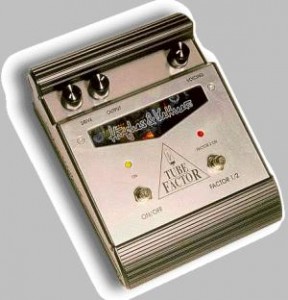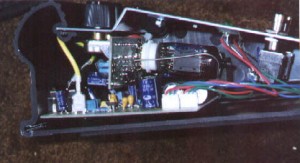Overdrive pedals that incorporate tubes have been around for many years. As the designs themselves have progressed, the sound of these devices have also improved significantly. For example, initially tube overdrive pedals ran the preamp tube or tubes with very low voltages and this changed the sonic characteristics of the effect. Many of today’s units however now run the tubes at the high plate voltages (in the neighborhood of 300 volts!) that the tubes were intended to be operated at.
In the months ahead, we hope to bring you a roundup of many different models of tube overdrive pedals. For now, we’ve taken a look at an especially impressive model: Hughes and Kettner’s Tube Factor.
Features
Hughes and Kettner’s Tube Factor is an overdrive/distortion pedal that features two gain modes, providing additional user versatility with a softer-clipping mode called “Factor 1”, as well as a harder-style distortion dubbed “Factor 2”. The Tube Factor uses a single 12AX7 (a.k.a. ECC-83) preamp tube for Factor 1 voicing. Factor 2 incorporates a diode circuit to add additional  gain. Before anyone cries out, “What? It’s not a ‘pure-tube’ signal!”, let me add a couple of points in Hughes and Kettner’s defense. First, the whole beauty of tubes and tube distortion in particular is the sense of dynamics that they induce. Tubes respond to a player’s touch; as you play harder, the tube’s distortion compresses and seems to “bend” naturally. Adding additional gain circuits on top of an initial preamp tube stage, whether it is tube or not, will certainly virtually eliminate this characteristic, and result in the “modern high-preamp gain” sound, popularized by amplifiers such as Mesa/Boogies Rectifier series. In fact, truth be told, it is really the power tubes in an amplifier that have the highest range of dynamics and feel. This is one of the primary reasons that the original Marshall Super Leads amplifiers are so highly regarded. But back to the diode issue, it should also be known that one of Marshall’s most famous and tone-full amplifiers, the Silver Jubilee 2555 100 watt head, also uses diodes for added clipping distortion. So ultimately, it is the sound that should concern the potential Tube Factor user because that is really what counts. The Tube Factor’s Factor 1 setting contains plenty of dynamics with rich harmonic overtones. Factor 2 simply takes over where Factor 1 leaves off with plenty of smooth distortion and sustain.
gain. Before anyone cries out, “What? It’s not a ‘pure-tube’ signal!”, let me add a couple of points in Hughes and Kettner’s defense. First, the whole beauty of tubes and tube distortion in particular is the sense of dynamics that they induce. Tubes respond to a player’s touch; as you play harder, the tube’s distortion compresses and seems to “bend” naturally. Adding additional gain circuits on top of an initial preamp tube stage, whether it is tube or not, will certainly virtually eliminate this characteristic, and result in the “modern high-preamp gain” sound, popularized by amplifiers such as Mesa/Boogies Rectifier series. In fact, truth be told, it is really the power tubes in an amplifier that have the highest range of dynamics and feel. This is one of the primary reasons that the original Marshall Super Leads amplifiers are so highly regarded. But back to the diode issue, it should also be known that one of Marshall’s most famous and tone-full amplifiers, the Silver Jubilee 2555 100 watt head, also uses diodes for added clipping distortion. So ultimately, it is the sound that should concern the potential Tube Factor user because that is really what counts. The Tube Factor’s Factor 1 setting contains plenty of dynamics with rich harmonic overtones. Factor 2 simply takes over where Factor 1 leaves off with plenty of smooth distortion and sustain.
The Tube Factor has a simple array of knob controls including one for drive, one for overall output level, and then a very interesting control called, “Voicing”. Turning the Voicing control to a fully clockwise position produces a sound reminiscent of a modern “scooped” gain sound, where various midrange frequencies are reduced from the signal. As you turn the Voicing control counter-clockwise, bluesier, punchier sounds come back into the mix with added presence. An additional feature of the Tube Factor beyond the basic ¼” input and output jacks is a remote jack that can be used to switch the Tube Factor’s two factor modes on or off remotely via a MIDI switcher. The Tube Factor also uses two separate on/off footswitches on the face of the unit. The footswitch to the far left is an On/Off Switch, while the one to the right, the Factor 1/2 Switch, is used for switching between the two available gain factors. An on/off LED as well as Factor LEDs are also on the unit. The Factor LED will illuminate to red when Factor 2 is selected.
An included 12-volt AC adapter powers the Tube Factor. Batteries are not an option and they would be eaten up rather quickly anyhow with the Tube Factor’s current consumption of 480mA!
Construction
The Tube Factor is sturdily built around a medium-gauge aluminum housing with plastic side panels. The design features a recessed area for the controls that virtually eliminates the possibility of accidentally breaking a knob or potentiometer if the unit is dropped. The Tube Factor also uses standard heavy-duty SPDT footswitches.
 Looking at the inside of the Tube Factor by removing either side panel, it can be seen that the Tube Factor’s design is based off of two circuit boards: one to hold the preamp tube socket and related components, the other for the primary circuit itself. While some may scoff at the mounting of a tube onto a circuit board, I think this is inconsequential with regards to preamp tubes, especially since they do not generate the same level of heat as their larger power tube cousins.
Looking at the inside of the Tube Factor by removing either side panel, it can be seen that the Tube Factor’s design is based off of two circuit boards: one to hold the preamp tube socket and related components, the other for the primary circuit itself. While some may scoff at the mounting of a tube onto a circuit board, I think this is inconsequential with regards to preamp tubes, especially since they do not generate the same level of heat as their larger power tube cousins.
The design of the Tube Factor is made so that removal and replacement of the tube itself is a bit difficult and I imagine this is the case because the company wants to discourage average users to do so. This is because there are high-plate voltages present that could possibly inflict damage to someone if they touched a charged capacitor, etc. for example. In fact, the User’s Guide asks that the unit never be opened by anyone other than a qualified, certified technician. While I “broke” that rule during photography, I did however respect the intention of the warning given in the safety guidelines in that I didn’t insert my hand inside the unit and touch anything.
Sound
While sound is always subjective, I can make a few initial comments. Regarding dynamics, Factor 1 did indeed illustrate a nice gradual overdrive effect that increased directly with my own heavier picking attack. This is demonstrated in the Sound Files section and can be heard for yourself. In addition, when I first saw the single Voicing control, I must admit I was disappointed and thought it would not provide enough tonal flexibility. However, I was pleased to discover that the Voicing control is very well tuned and provides a very diverse and more importantly, useable, range of settings. When kicking in Factor 2 and setting the Voicing control to a ¾ to fully clockwise position, sounds reminiscent of newer, modern gain high-gain amps were produced. Turning the Voicing control nearly all the way counter clockwise with Factor 1 turned on reminded me of a Tube Screamer’s tone – full and present, but with not quite as much midrange as a Tube Screamer.
The User’s Manual included with the Tube Factor is basic, but includes all of the necessary feature information, technical data, as well as recommended settings to try. The manual is clear, simple, and to the point and that is certainly appreciated. Those that read German will gain the added bonus of the manual being written in that language as well.
A last point to mention is that the tube itself within the Tube Factor is powered with high voltage, in the same way as that found within a normal tube amplifier. Nearly 300 volts runs through the preamp tube itself, providing accurate preamp tube distortion. It should be noted that some “tube-based” overdrive models out on the market use very low voltages that effectively will put the tube in a type of “starvation” mode for gain creation. It is my opinion that those types of devices are nothing more than marketing gimmickry, jumping onto a kind of “tube bandwagon”, solely because they aren’t powering the tubes as they are intended.
The Tube Factor also makes an excellent, albeit expensive “clean boost” pedal. Those that have read our Tone Tips section already know about how the increased amount of input voltage via a clean boosted signal can strengthen and enhance the tone of great, older tube amps in need of a little “kick”. While the Tube Factor does do an excellent job of a boost and provides up to 12 dB of it, other non-tube pedals can do this same trick just as well, and at a lower cost. Having said that however, those interested in using a clean boost, as well as having an additional option of some gain patched in via Factor 2, will find that the Tube Factor makes a great choice.
Factor 1 provides many pleasing tones and dynamics and Factor 2 satisfies the need for added gain levels. Factor 2’s distortion characteristics were both smooth and pleasing to my ears. Additionally, the signal was not noisy in either Factor modes unlike the way cheaper distortion boxes can be. All in all, testing and playing with Hughes and Kettner’s Tube Factor was a great experience and I’m very impressed with the amount of great and usable tones that are present. This is not a “one good sound” only pedal. Blues, rock, and metal players will all find great sounds from the Tube Factor.
Conclusion and Overall Rating
The Hughes and Kettner Tube Factor is clearly well designed, well constructed, and sounds good in virtually all the settings used. Its $299 suggested retail price may be considered steep by some, but obviously actual street prices will be significantly lower and I’ve always felt it is best to pay a little more for something of quality rather than sacrifice the tone you’re looking for and buy “cheap” gear instead. While I would prefer a design that incorporates things like a built-in power transformer and a removable power cord like those used in amplifiers, rather than a “wallwart” power adapter design, these are relatively minor complaints. I also do wish that the Tube Factor’s design allowed for easier removal of the tubes, especially since many players like to experiment with different tube types and brands. And while the Tube Factor is not a “pure” tube signal when running in Factor 2 mode, I still think that this doesn’t matter since the distortion characteristics are very smooth and the unit simply sounds great. With regard to sound, this is a personal preference and perhaps the best point of advice is of course to “try before you buy”. If this isn’t possible, give a listen to the sound files page to get a basic idea of a couple of the Tube Factor’s basic sounds and do understand that many other great sounds can be had from the Tube Factor. Check out Hughes and Kettner out on the web at http://www.hughes-and-kettner.com.